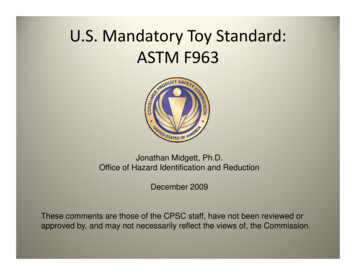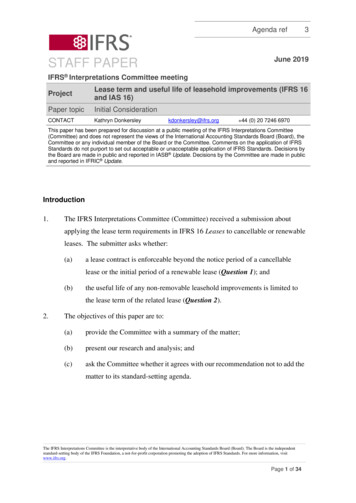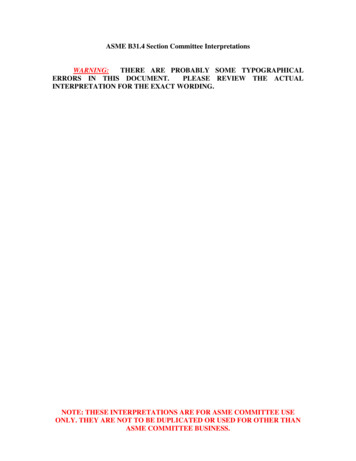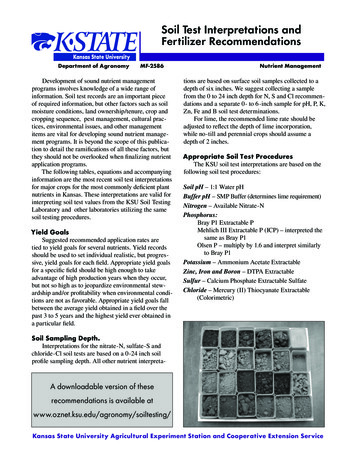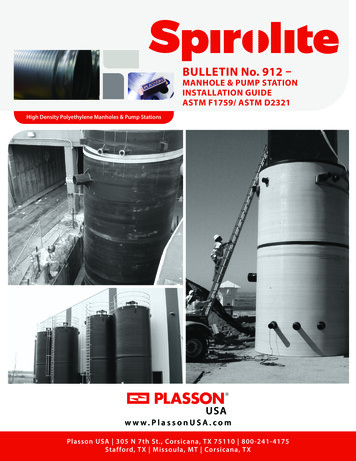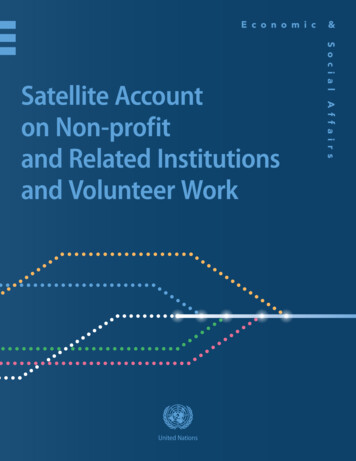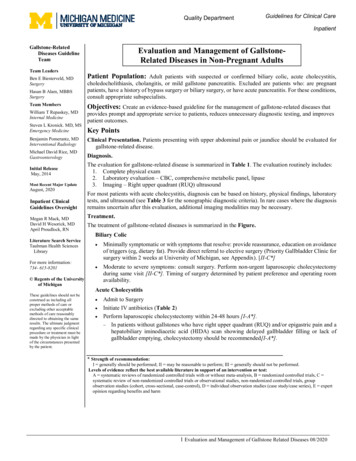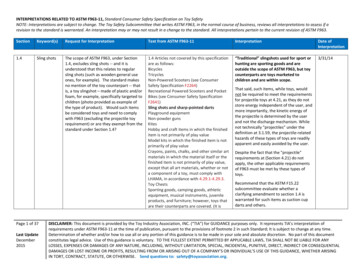
Transcription
INTERPRETATIONS RELATED TO ASTM F963-11, Standard Consumer Safety Specification on Toy SafetyNOTE: Interpretations are subject to change. The Toy Safety Subcommittee that writes ASTM F963, in the normal course of business, reviews all interpretations to assess if arevision to the standard is warranted. An interpretation may or may not result in a change to the standard. All interpretations pertain to the current revision of ASTM F963.SectionKeyword(s)Request for InterpretationText from ASTM F963-11InterpretationDate ofInterpretation1.4Sling shotsThe scope of ASTM F963, under Section1.4, excludes sling shots -- and it isunderstood that this relates to regularsling shots (such as wooden general useones, for example). The standard makesno mention of the toy counterpart -- thatis, a toy slingshot – made of plastic and/orfoam, for example, specifically targeted tochildren (photo provided as example ofthe type of product). Would such itemsbe considered toys and need to complywith F963 (excluding the projectile toyrequirement) or are they exempt from thestandard under Section 1.4?1.4 Articles not covered by this specificationare as follows:BicyclesTricyclesNon-Powered Scooters (see ConsumerSafety Specification F2264)Recreational Powered Scooters and PocketBikes (see Consumer Safety SpecificationF2641)Sling shots and sharp-pointed dartsPlayground equipmentNon-powder gunsKitesHobby and craft items in which the finisheditem is not primarily of play valueModel kits in which the finished item is notprimarily of play valueCrayons, paints, chalks, and other similar artmaterials in which the material itself or thefinished item is not primarily of play value,except that all art materials, whether or nota component of a toy, must comply withLHAMA, in accordance with 4.29.1-4.29.3.Toy ChestsSporting goods, camping goods, athleticequipment, musical instruments, juvenileproducts, and furniture; however, toys thatare their counterparts are covered. (It is“Traditional” slingshots used for sport orhunting are sporting goods and areoutside the scope of ASTM F963, but toycounterparts are toys marketed tochildren and are within scope.3/31/14Page 1 of 37Last UpdateDecember2015That said, such items, while toys, wouldnot be required to meet the requirementsfor projectile toys at 4.21, as they do notstore energy independent of the user, andmore importantly, the kinetic energy ofthe projectile is determined by the userand not the discharge mechanism. Whilenot technically "projectiles" under thedefinition at 3.1.59, the projectile-relatedhazards of these types of toys are readilyapparent and easily avoided by the user.Despite the fact that the "projectile"requirements at (Section 4.21) do notapply, the other applicable requirementsof F963 must be met by these types oftoys.Recommend that the ASTM F15.22subcommittee evaluate whether aclarifying amendment to section 1.4 iswarranted for such items as suction cupdarts and others.DISCLAIMER: This document is provided by the Toy Industry Association, INC. (“TIA”) for GUIDANCE purposes only. It represents TIA's interpretation ofrequirements under ASTM F963-11 at the time of publication, pursuant to the provisions of footnote 2 in such Standard; It is subject to change at any time.Determination of whether and/or how to use all or any portion of this guidance is to be made in your sole and absolute discretion. No part of this documentconstitutes legal advice. Use of this guidance is voluntary. TO THE FULLEST EXTENT PERMITTED BY APPLICABLE LAWS, TIA SHALL NOT BE LIABLE FOR ANYLOSSES, EXPENSES OR DAMAGES OF ANY NATURE, INCLUDING, WITHOUT LIMITATION, SPECIAL, INCIDENTAL, PUNITIVE, DIRECT, INDIRECT OR CONSEQUENTIALDAMAGES OR LOST INCOME OR PROFITS, RESULTING FROM OR ARISING OUT OF A COMPANY’S OR INDIVIDUAL’S USE OF THIS GUIDANCE, WHETHER ARISINGIN TORT, CONTRACT, STATUTE, OR OTHERWISE. Send questions to: safety@toyassociation.org.
INTERPRETATIONS RELATED TO ASTM F963-11, Standard Consumer Safety Specification on Toy SafetyNOTE: Interpretations are subject to change. The Toy Safety Subcommittee that writes ASTM F963, in the normal course of business, reviews all interpretations to assess if arevision to the standard is warranted. An interpretation may or may not result in a change to the standard. All interpretations pertain to the current revision of ASTM 1.3(4)8.19.1.4(3)Page 2 of 37Last UpdateDecember2015Request for InterpretationText from ASTM F963-11What is the definition of a push/pull toy?This type of toy is referenced in the SafetyRequirements and Test Methods sectionsbut is not specifically defined.recognized that there is often a fine linebetween, for example, a musical instrumentor a sporting item and its toy counterpart.The intention of the producer or distributor,as well as normal use and reasonablyforeseeable abuse, determines whether theitem is a toy counterpart.)Powered models of aircraft, rockets, boats,and land vehicles; however, toys that aretheir counterparts are covered.Constant air inflatables4.14.1 Cords, Straps, and Elastics in Toys—Cords or elastics included with or attachedto toys intended for children less than 18months of age (excluding pull toys, see4.14.3) shall be less than 12 in. (300 mm)long when measured to the maximumlength in a free state and under a load of 5lb (2.25 kg). If cords/straps/elastics ormultiple cords/straps/ elastics can tangle orform a loop in connection with any part ofthe toy, including beads or otherattachments on the ends ofcords/straps/elastics, the loop shall notpermit the passage of the head probe (Fig.10) when tested in accordance with 8.22.There is differing understanding of this inthe market. Consider this example: a toythat is intended for floor or table top playwhere the intended play pattern is for thechild to push/pull the toy with their hand,thus generating motion and sound.Would this be classified as a push/pull toy-- due to play pattern? Or is a push/pulltoy intended for use by a child in astanding/upright position and thus thefollowing definition would address thisquestion:3.1.X Push/Pull Toys - a toy with a section text continues in standard InterpretationDate ofInterpretationThe intended meaning of “push/pull toy”is a product intended to be used on thefloor or ground, with the child in anupright or standing position, and whichthus requires an attached handle, cord, orsimilar element; this represents how theterm has historically been used in themarket.8/28/12We concur with the requestor’s proposalto add a definition for “push/pull toy” tosection 3.1 of the standard and with thewording suggested.Further propose that the ASTM F15.22subcommittee evaluate whether the term“pull toy” currently utilized in sections4.14.1 and 4.14.3 should be revised toDISCLAIMER: This document is provided by the Toy Industry Association, INC. (“TIA”) for GUIDANCE purposes only. It represents TIA's interpretation ofrequirements under ASTM F963-11 at the time of publication, pursuant to the provisions of footnote 2 in such Standard; It is subject to change at any time.Determination of whether and/or how to use all or any portion of this guidance is to be made in your sole and absolute discretion. No part of this documentconstitutes legal advice. Use of this guidance is voluntary. TO THE FULLEST EXTENT PERMITTED BY APPLICABLE LAWS, TIA SHALL NOT BE LIABLE FOR ANYLOSSES, EXPENSES OR DAMAGES OF ANY NATURE, INCLUDING, WITHOUT LIMITATION, SPECIAL, INCIDENTAL, PUNITIVE, DIRECT, INDIRECT OR CONSEQUENTIALDAMAGES OR LOST INCOME OR PROFITS, RESULTING FROM OR ARISING OUT OF A COMPANY’S OR INDIVIDUAL’S USE OF THIS GUIDANCE, WHETHER ARISINGIN TORT, CONTRACT, STATUTE, OR OTHERWISE. Send questions to: safety@toyassociation.org.
INTERPRETATIONS RELATED TO ASTM F963-11, Standard Consumer Safety Specification on Toy SafetyNOTE: Interpretations are subject to change. The Toy Safety Subcommittee that writes ASTM F963, in the normal course of business, reviews all interpretations to assess if arevision to the standard is warranted. An interpretation may or may not result in a change to the standard. All interpretations pertain to the current revision of ASTM F963.Section3.1.5616 CFR1500.48Keyword(s)Sharp pointsand sharpedgesRequest for Interpretationcord/tether and/or a handle attachedto the toy and where the toy isintended for use on the ground withthe child in a standing/uprightposition, typically walking, while usingthe toy.In regards to assessing sharp points forchildren’s products (toys), both ASTMF963 and related 16 CFR1500.48 utilizethe sharp point tester. ASTM furtherdefines “point, hazardous” as “anaccessible point that presents anunreasonable risk of injury during normaluse or reasonably foreseeable abuse.Points on toys intended for children underthe age of 8 years are potentiallyhazardous if they fail the sharp point testdescribed in 16 CFR 1500.48.”The underlined statement in the ASTMdefinition could be interpreted as theillumination of the sharp point testerdeems a failure to ASTM F963. However,the CFR provides the following languagerelated to performing a risk assessment todetermine if any regulatory action iswarranted: “The Commission will furtherevaluate points that are identified aspresenting a potential risk of puncture orPage 3 of 37Last UpdateDecember2015Text from ASTM F963-11InterpretationDate ofInterpretation“push/pull toy.”3.1.56 point, hazardous—an accessible pointthat presents an unreasonable risk of injuryduring normal use or reasonably foreseeableabuse. Points on toys intended for childrenunder the age of 8 years are potentiallyhazardous if they fail the sharp point testdescribed in 16 CFR 1500.48. section text continues in standard 16 CFR 1500.481500.48 Technical requirements fordetermining a sharp point in toys and otherarticles intended for use by children under 8years of age.(a) Objective. The sharp point testprescribed by paragraph (d) of this sectionwill be used by the Commission in making apreliminary determination that points ontoys and other articles intended for use bychildren under 8 years of age, and suchpoints exposed in normal use or as a resultIf a point or metal/glass edge “fails” thetechnical requirement, labs shouldproceed to a hazard evaluation, and if adetermination is made that nounreasonable risk of injury exists, asimple “pass” report should be issued.A lab may indicate that thedetermination was based upon a hazardevaluation.12/11/13The intent is for ASTM F963 to mirror therequirements in 16CFR 1500.48 and1500.49 -- and subsequently to include arisk assessment as needed.The sharp point test and the sharp edgetest for metal and glass edges are bothtechnical requirements intended only toprovide initial triage; if a “failure” of oneof these technical requirements occurs, itis intended that there be a subsequentevaluation of the hazard presented (if any)to determine if an unreasonable risk ofDISCLAIMER: This document is provided by the Toy Industry Association, INC. (“TIA”) for GUIDANCE purposes only. It represents TIA's interpretation ofrequirements under ASTM F963-11 at the time of publication, pursuant to the provisions of footnote 2 in such Standard; It is subject to change at any time.Determination of whether and/or how to use all or any portion of this guidance is to be made in your sole and absolute discretion. No part of this documentconstitutes legal advice. Use of this guidance is voluntary. TO THE FULLEST EXTENT PERMITTED BY APPLICABLE LAWS, TIA SHALL NOT BE LIABLE FOR ANYLOSSES, EXPENSES OR DAMAGES OF ANY NATURE, INCLUDING, WITHOUT LIMITATION, SPECIAL, INCIDENTAL, PUNITIVE, DIRECT, INDIRECT OR CONSEQUENTIALDAMAGES OR LOST INCOME OR PROFITS, RESULTING FROM OR ARISING OUT OF A COMPANY’S OR INDIVIDUAL’S USE OF THIS GUIDANCE, WHETHER ARISINGIN TORT, CONTRACT, STATUTE, OR OTHERWISE. Send questions to: safety@toyassociation.org.
INTERPRETATIONS RELATED TO ASTM F963-11, Standard Consumer Safety Specification on Toy SafetyNOTE: Interpretations are subject to change. The Toy Safety Subcommittee that writes ASTM F963, in the normal course of business, reviews all interpretations to assess if arevision to the standard is warranted. An interpretation may or may not result in a change to the standard. All interpretations pertain to the current revision of ASTM F963.SectionKeyword(s)Request for InterpretationText from ASTM F963-11Interpretationlaceration injury to determine the needfor individual product regulatory action.”of reasonably foreseeable damage or abuseof such toys and articles, present a potentialrisk of injury by puncture or laceration undersection 2(s) of the Federal HazardousSubstances Act (15 U.S.C. 1261(s)). TheCommission will further evaluate points thatare identified as presenting a potential riskof puncture or laceration injury todetermine the need for individual productregulatory action.injury exists. Such factors as type ofmaterial, location on the product (e.g. if asharp point is on a small broken-off piecewhich is likely to be discarded, this wouldbe of lesser concern than one remainingon a functional product, and a sharp pointon an area of the product that isfrequently handled would likely be ofgreater concern than one in an areawhere only incidental contact can bemade, or that is difficult to access), etc.should be considered as part of thisevaluation. Perhaps the most salientexample is a common paper clip-when anend is bent out, it enters and lights thesharp point gauge due to its dimensions(diameter 0.040”), but this would not beconsidered to present an unreasonablerisk of injury.rdThe question is, are CPSC accredited 3party laboratory allowed to perform riskassessments if a technical sharp point isidentified (illumination of the sharp pointtester) in determining compliance withASTM F963 and 16CFR1500.48 --- or is thisreserved for the Commission? . section text continues in CFR Date ofInterpretationThe intent is for CPSC-accredited labs tobe able to perform th
requirements under ASTM F963-11 at the time of publication, pursuant to the provisions of footnote 2 in such Standard; It is subject to change at any time. Determination of whether and/or how to use all or any portion of this guidance is to be made in your sole and absolute discretion. No part of this document constitutes legal advice. Use of this guidance is voluntary. TO THE FULLEST EXTENT .
